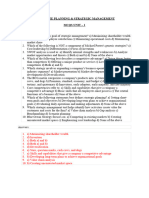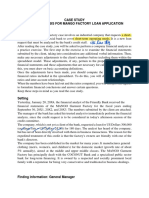Strategy and Technology: A Practical Primer Week 3 - Strategy Execution Assignment Questions 2023
Strategy and Technology: A Practical Primer Week 3 - Strategy Execution Assignment Questions 2023
Uploaded by
tarun.gautam2000Copyright:
Available Formats
Strategy and Technology: A Practical Primer Week 3 - Strategy Execution Assignment Questions 2023
Strategy and Technology: A Practical Primer Week 3 - Strategy Execution Assignment Questions 2023
Uploaded by
tarun.gautam2000Original Title
Copyright
Available Formats
Share this document
Did you find this document useful?
Is this content inappropriate?
Copyright:
Available Formats
Strategy and Technology: A Practical Primer Week 3 - Strategy Execution Assignment Questions 2023
Strategy and Technology: A Practical Primer Week 3 - Strategy Execution Assignment Questions 2023
Uploaded by
tarun.gautam2000Copyright:
Available Formats
Strategy and Technology: A Practical Primer
Week 3 – Strategy Execution
Assignment Questions 2023
Q1) The right sequence of imagining a future state of a company is (the sequence starting from the
left):
a. Mission-Vision-Objectives-Strategy-Execution
b. Vision-Objectives-Mission-Strategy-Execution
c. Vision-Mission-Strategy-Objectives-Execution
d. Vision-Mission-Objectives-Strategy-Execution
Q2) Which of the following is a barrier to entry set up by an incumbent?
a. Lack of purchase stickiness by customers to an incumbent
b. Strong product strengths of the incumbent
c. Dependence on competitors’ channels by the incumbent
d. Low scale and scope of the incumbent
Q3) FMCG companies build value through:
a. Transactional selling
b. Product servicing
c. Exports
d. Brand building
Q4) The vision of a typical large multinational pharmaceutical corporation is focused on:
a. Shareholder returns
b. Company scale and scope
c. Serving patients and doctors
d. None of the above
Q 5) When a growth-oriented company cannot undertake a market entry by itself for a product
already designed and manufactured by it, the company should:
a. Close the business
b. Stay put with the sunk costs waiting for better times
c. Sell off the new product line
d. Execute strategic marketing alliances
Q 6) Which country has exhibited a capability to execute challenging infrastructure projects in time
without overruns?
a. India
b. Malaysia
c. Indonesia
d. Japan
Q 7) Matrix organization in global MNCs predominantly provides:
a. Burdensome bureaucracy
b. Regional autonomy
c. Headquarter control
d. Expert to expert interaction on global-local basis
Q 8) Hospira’s success after Mike Ball took over as the CEO can be attributed, besides strategy and
execution, to:
a. The nature of pharma industry
b. Top-down management
c. Sustained cultural transformation
d. Annual global summits
Q 9) The long range planning era of the 1970s involved:
a. Competitive strategy theory of Porter
b. Operations Research
c. Simple incremental planning
d. Only annual budgeting
Q 10) Given the fast-changing technologies driving Industry 4.0, strategic management for the 2020s
should involve greater integration of: (Note: Choose the most appropriate answer).
a. Strategy and Metrics
b. Strategy and Business
c. Strategy and Technology
d. Software and Hardware
You might also like
- EGMC004 Final ExamDocument13 pagesEGMC004 Final Examkunwar anejaNo ratings yet
- Marketing Canadian 3rd Edition Grewal Test BankDocument31 pagesMarketing Canadian 3rd Edition Grewal Test BankLobna QassemNo ratings yet
- Quiz Stratergy ManagementDocument3 pagesQuiz Stratergy ManagementmaliklduNo ratings yet
- Chapter 2 Strategic Planning in Contemporary MarketingDocument30 pagesChapter 2 Strategic Planning in Contemporary MarketingWilliam ZhangNo ratings yet
- MCQ CSDocument9 pagesMCQ CSrattan billawariaNo ratings yet
- Assignment 5Document3 pagesAssignment 5poddarprateek1No ratings yet
- Strategic Planning and Marketting Segmentation McqsDocument5 pagesStrategic Planning and Marketting Segmentation McqsHaritha HaribabuNo ratings yet
- Strategic Management 2 Contributed by Neeraj DangiDocument8 pagesStrategic Management 2 Contributed by Neeraj DangiVijayuduGnanamkondaNo ratings yet
- Strategic Management: Multiple Choice Questions (20 x1 20M)Document5 pagesStrategic Management: Multiple Choice Questions (20 x1 20M)IndhuNo ratings yet
- Marketing Strategy Quiz Bank: (The Answers For Each Question Have Been Highlighted in Bold For Each Question)Document15 pagesMarketing Strategy Quiz Bank: (The Answers For Each Question Have Been Highlighted in Bold For Each Question)HbNo ratings yet
- Marketing questionsDocument7 pagesMarketing questionsAnanth Venkata RamanNo ratings yet
- UEF Strategy 2023 Multiple Choice NoDocument115 pagesUEF Strategy 2023 Multiple Choice Nolinh nguyễn báNo ratings yet
- Quiz 1 Strategic Sept 4 2022Document14 pagesQuiz 1 Strategic Sept 4 2022Mae FernNo ratings yet
- Book 63 7B Strategic ManagementDocument12 pagesBook 63 7B Strategic ManagementRoshinisai VuppalaNo ratings yet
- MCQ Ch 4 - Strategic ChoiceDocument14 pagesMCQ Ch 4 - Strategic Choiceriazulsk471No ratings yet
- MCQ Ch 2 - Strategic Analysis External EnviromentDocument8 pagesMCQ Ch 2 - Strategic Analysis External Enviromentriazulsk471No ratings yet
- Mgt211 Mcqs File For Papers and QuizDocument33 pagesMgt211 Mcqs File For Papers and QuizIram shehzadi100% (1)
- MGT211 Introduction To Business Solved Midterm Subjective and Objective For Preparation of Midterm Exam PDFDocument37 pagesMGT211 Introduction To Business Solved Midterm Subjective and Objective For Preparation of Midterm Exam PDFAqib GNo ratings yet
- Marketing StrategyDocument21 pagesMarketing Strategy44 - Nguyễn Thị Phương NhungNo ratings yet
- Zcma6082 Quiz 1Document4 pagesZcma6082 Quiz 1maliklduNo ratings yet
- MCQ 200Document261 pagesMCQ 200Shubham jainNo ratings yet
- SBM 50 MCQ - 1507053416739Document5 pagesSBM 50 MCQ - 1507053416739VasuNo ratings yet
- Idt Prep. Exam QBDocument17 pagesIdt Prep. Exam QBharibhadurshingNo ratings yet
- Master of Business Administration SEMESTER 2 2019/2020 Zcme6082 Corporate Strategy Quiz (20 PERCENT)Document5 pagesMaster of Business Administration SEMESTER 2 2019/2020 Zcme6082 Corporate Strategy Quiz (20 PERCENT)maliklduNo ratings yet
- MCQs For BMDocument12 pagesMCQs For BMAbdul RaufNo ratings yet
- GM 14 Assignment 01Document4 pagesGM 14 Assignment 01Hemkesh RoheraNo ratings yet
- Stretegic MangtDocument5 pagesStretegic Mangtaarti kashyapNo ratings yet
- B. Marketing Mix: D. Promotional ActivitiesDocument19 pagesB. Marketing Mix: D. Promotional ActivitiesAjit Surana100% (1)
- Mgt211 Quiz File SOLVEDDocument30 pagesMgt211 Quiz File SOLVEDAman KhanNo ratings yet
- Chapter 1 What Is Strategy and Why Is It Important?Document21 pagesChapter 1 What Is Strategy and Why Is It Important?bobNo ratings yet
- Strategic Management McqsDocument80 pagesStrategic Management Mcqsadityakr0624No ratings yet
- SM MCQ BookDocument25 pagesSM MCQ BookmuhammedhadhindinuNo ratings yet
- 719567780 Tổng on giữa ki va cuối ki QTVH.vi.enDocument32 pages719567780 Tổng on giữa ki va cuối ki QTVH.vi.entienkhoa200604No ratings yet
- Chapter One: The Nature of Strategic ManagementDocument70 pagesChapter One: The Nature of Strategic ManagementNong LegacionNo ratings yet
- A. Harvest Strategy B. Maintain Strategy C. Consolidated Strategy D. Differentiation StrategyDocument23 pagesA. Harvest Strategy B. Maintain Strategy C. Consolidated Strategy D. Differentiation Strategypn7659280No ratings yet
- Stategies ManaDocument23 pagesStategies ManaHuy Ha HoangNo ratings yet
- GST106 Multiple Choice Questions +answers by B. SC??Document25 pagesGST106 Multiple Choice Questions +answers by B. SC??k31372737No ratings yet
- Ptvaim MMS SMDocument4 pagesPtvaim MMS SMShweta SinghNo ratings yet
- Solved Sample+ Midterm++PomDocument11 pagesSolved Sample+ Midterm++PomHooria SiddiquiNo ratings yet
- SMM QuizletDocument21 pagesSMM QuizletGia Bao DangNo ratings yet
- TestBank Chapter-1Document39 pagesTestBank Chapter-1BAHAA SALEHNo ratings yet
- GM14Document11 pagesGM14Avinash KaurNo ratings yet
- Test BankDocument17 pagesTest BankMema Slimam100% (1)
- Strategic Management Mcqs Unit 1Document15 pagesStrategic Management Mcqs Unit 1Hemant Kumar AhirwarNo ratings yet
- Muhammad Bilal F2020052025 Midterm ExamDocument5 pagesMuhammad Bilal F2020052025 Midterm ExamMuneeb AhmadNo ratings yet
- MKT Strategy - Final - ANSDocument41 pagesMKT Strategy - Final - ANSnhaan.studyNo ratings yet
- EGMC004 - Strategic Management (Kunwar)Document162 pagesEGMC004 - Strategic Management (Kunwar)kunwar anejaNo ratings yet
- Strategic ManagementDocument12 pagesStrategic ManagementManasa RamachandruniNo ratings yet
- Business Seminar Exam PrepDocument8 pagesBusiness Seminar Exam PrepBarbara DiasNo ratings yet
- MGT 211 McqsDocument36 pagesMGT 211 McqsAsifNo ratings yet
- Marketing Management - I by Prof. Jayanta Chatterjee & Prof. Shashi ShekharDocument3 pagesMarketing Management - I by Prof. Jayanta Chatterjee & Prof. Shashi ShekharKuntal DattaNo ratings yet
- Model AnswerDocument6 pagesModel Answerbody.helal2001No ratings yet
- SM Multiple Choice 1Document6 pagesSM Multiple Choice 1Tú Anh NguyễnNo ratings yet
- Quản-trị-chiiến-lược-ôn-tậpDocument58 pagesQuản-trị-chiiến-lược-ôn-tậpdangthithanhbinh267No ratings yet
- Bài tập trắc nghiệm mớiDocument92 pagesBài tập trắc nghiệm mớiTrang NguyenNo ratings yet
- Assignment 1Document17 pagesAssignment 1ShammimBegumNo ratings yet
- SM MCQ 30m OldDocument5 pagesSM MCQ 30m OldRayyan AnsariNo ratings yet
- Strategic Management: Formulate and Implement Strategies, Analyze the Competitive Environment and Make Strategic Decisions: Administration: The science of managing resourcesFrom EverandStrategic Management: Formulate and Implement Strategies, Analyze the Competitive Environment and Make Strategic Decisions: Administration: The science of managing resourcesNo ratings yet
- Chapter 7 ExamplesDocument18 pagesChapter 7 Examplesm bNo ratings yet
- Dissertation Life InsuranceDocument9 pagesDissertation Life InsuranceGhostWriterForCollegePapersFargo100% (2)
- Daftar Akun PT ManunggalDocument4 pagesDaftar Akun PT ManunggalPetty Silvi Nova MaharlikaNo ratings yet
- Referral Deferral Assessement 2 2020 21Document2 pagesReferral Deferral Assessement 2 2020 21KakaNo ratings yet
- Chapter 16-Monopolistic Competition-Đã M KhóaDocument8 pagesChapter 16-Monopolistic Competition-Đã M Khóaminhhuynh.31241027282No ratings yet
- Capital Budgeting Under UnCertaintyDocument25 pagesCapital Budgeting Under UnCertaintyAdeolaNo ratings yet
- "Should The Store Be Closed Permanently" DecisionDocument2 pages"Should The Store Be Closed Permanently" DecisionBrian Minh TranNo ratings yet
- Study Guide Module 5 Price ManagementDocument6 pagesStudy Guide Module 5 Price ManagementSamantha SmithNo ratings yet
- Accountancy Set B (Answer Key)Document23 pagesAccountancy Set B (Answer Key)Santhi SNo ratings yet
- CA Inter Tax QP May 2024Document14 pagesCA Inter Tax QP May 2024mishrag7722No ratings yet
- Delcer High School-CooperativesDocument1 pageDelcer High School-CooperativesKerine Williams FigaroNo ratings yet
- Case Study Mango - QuestionDocument7 pagesCase Study Mango - QuestionVi Phạm Thị HàNo ratings yet
- FIN403 Review Chapter 1 5Document9 pagesFIN403 Review Chapter 1 5Hoang Thanh HangNo ratings yet
- IMF AssignmentDocument11 pagesIMF AssignmentIbrahim BadshaNo ratings yet
- CGT Gain or Loss Worksheet 2022Document2 pagesCGT Gain or Loss Worksheet 2022Snow SnowpiNo ratings yet
- Loans Receivable QuizDocument2 pagesLoans Receivable Quizann chrislynNo ratings yet
- Sanika, Pranay, Ansh, Anjul - Impact of Global Financial Crisis On Indian Market Index, NIFTY 50Document30 pagesSanika, Pranay, Ansh, Anjul - Impact of Global Financial Crisis On Indian Market Index, NIFTY 50Pranay AgarwalNo ratings yet
- CHAPTER 8 Analyzing Financial Statements and Creating ProjectionsDocument13 pagesCHAPTER 8 Analyzing Financial Statements and Creating ProjectionsDanica PobleteNo ratings yet
- Quiz 2Document20 pagesQuiz 2randomlungs121223No ratings yet
- B) Size of BusinessesDocument6 pagesB) Size of BusinessesVajan SelvaratnamNo ratings yet
- Quiz 1 ForexDocument8 pagesQuiz 1 ForexSara ChanNo ratings yet
- Here Are Some IdeasDocument3 pagesHere Are Some IdeasBrahim OuhammouNo ratings yet
- Financial Management Theory & Practice-1083-1084Document2 pagesFinancial Management Theory & Practice-1083-1084Syed Farhan AliNo ratings yet
- Asii LK TW Iii 2017Document118 pagesAsii LK TW Iii 2017Hakem_RNo ratings yet
- Financial Structure of EgyptDocument28 pagesFinancial Structure of EgyptNesma HusseinNo ratings yet
- Infinity Padel by Infinity Sports - 04.korrapdfDocument26 pagesInfinity Padel by Infinity Sports - 04.korrapdfSegunNo ratings yet
- RevisionDocument34 pagesRevisionTZE TUNG NGNo ratings yet
- BacktestDocument134 pagesBacktestKautsarrahman KautsarrahmanNo ratings yet
- Chapter 4-Planning - Developing Business & Acquisition PlansDocument6 pagesChapter 4-Planning - Developing Business & Acquisition Plans1954032027cucNo ratings yet
- Bank F3Document1 pageBank F3Minh NguyễnNo ratings yet

























































































